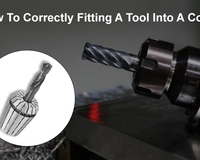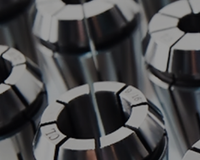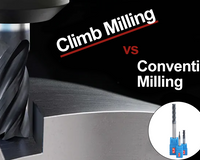Short of much more expensive solutions, ER collets are one of the best tool holding systems available. However, incorrectly fitting your router bit into an ER collet can lead to multiple issues, and this blog is going to address those issues, offer solutions and explain the reasons why it’s important to maintain and change your collets on a regular basis.
Selecting the right collet
It is essential to use the correct size collet for your tool shank diameter. Firstly, make sure you are looking at the right type of collet to fit the spindle on your machine. A common mistake is trying to fit a 6mm shank tool into a ¼” collet. It will go in and you can tighten it, but you’ll be stressing the collet.
Use the table below to select the right collet type. The example spindles shown are just a small selection of where these collets can be used. Even if your spindle is listed the best way to check compatibility is to compare the dimensions in the table with one of your existing collets.
The importance of correctly fitting your tool into your collet
Choosing the wrong collet type, collet size, or incorrectly fitting your tool into your collet can cause a number of problems to your workpiece, tooling and/or machine.
Here are a few examples of what can go wrong:
- Poor quality cutting
- Premature tool failure
- Damage to the spindle
- Damage to the collet
- Damage to the tool
- Damage to the machine bed
- Misalignment of the tool
How do you correctly fit a tool into a collet?
- Firstly, make sure you have the right size collet for the tool to be used. Push the collet into the locknut until it clicks into position. In order to successfully engage your collet with the locking ring of the nut, insert it at a slight angle.
- Screw the nut loosely onto the spindle or tool holder cone.
- Insert the tool into the collet. The tool should fill at least 80% of the collet bore but do not allow any of the cutting flute to enter the collet.
The next step is ensuring you tighten your collet to the correct torque.
Take care to tighten the locknut securely on the spindle but make sure you don’t over tighten it.
If you under tighten the collet there is a chance that the tool could be pulled out of the collet whilst cutting, especially if you are using an upward spiral flute, potentially damaging the machine bed and this will pose a health and safety risk.
If you over tighten the collet you risk damaging the cutter and misaligning the tool which will invariably result in a poor-quality finished product, never mind the wasted material and time.
In order to successfully remove your tool from your collet, unscrew the locknut from the spindle. Then remove the tool before snapping the collet out of the locknut by pushing the top of the collet sideways.
Remember – collet maintenance!
Collets have a life span of 400-600 hours, which roughly translates to between two and three months assuming the collet is used eight hours a day. When inspecting your collet, metallic damage, such as bell mouthing or burrs, should be checked with every tool change. If damage is visible, the collet should be discarded and replaced.
By replacing your collet as suggested, you ensure your operations run consistently, good cut quality is maintained and the life of your cutting tools is prolonged.
When replacing the collet, make sure the flute fadeout does not enter the collet, as this will result in runout and can potentially lead to tool breakage. To ensure proper clamping, the tool shank should fill, at the minimum, 80% of the depth of the collet.
You can purchase CNC tooling and Collets on RRToolStore – India Ka Apna Tool Store.





